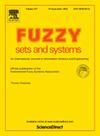Rational linear kernelized weighted fuzzy rough attribute selection with class separability
IF 2.7
1区 数学
Q2 COMPUTER SCIENCE, THEORY & METHODS
引用次数: 0
Abstract
Attribute selection is widely used in data mining to reduce dimensionality and computational overhead, which improves the generalization and efficiency of machine learning models. However, it is a challenging task to select the most representative subset of attributes from data characterized by uncertainty, sparsity, and heterogeneity. Most existing fuzzy rough set-based attribute selection methods focus on improving specific characteristics without a comprehensive consideration, limiting their effectiveness. Moreover, these methods overlook the class distribution information in data, which leads to poor representation of the selected attribute subset. Motivated by these issues, a Rational Linear kernelized weighted fuzzy rough attribute selection method with class separability (RLWAS-CS) is proposed in this paper. A Rational Linear (RL) kernelized fuzzy similarity relation, derived from the Rational Quadratic kernel and mixed attribute distance measure, is first defined to accurately capture sample similarities in sparse and heterogeneous space. On this basis, an RL kernelized weighted fuzzy rough set model (RLWFRS) is proposed. In this model, the weight comprehensively reflects the membership between the sample and each class in the complete attribute space, which improves the discriminability of fuzzy approximation membership and enhances its ability to handle uncertainty. Additionally, an attribute evaluation function is designed based on the RLWFRS model. It integrates class separability and captures both the class distribution characteristics and the dynamic relation between attribute separability and redundancy. Finally, the RLWAS-CS algorithm is presented for the attribute selection. Experimental results show that RLWAS-CS outperforms baseline methods in effectiveness.
具有类可分性的合理线性核加权模糊粗糙属性选择
属性选择在数据挖掘中广泛应用,降低了维数和计算量,提高了机器学习模型的泛化和效率。然而,从具有不确定性、稀疏性和异质性的数据中选择最具代表性的属性子集是一项具有挑战性的任务。现有的基于模糊粗糙集的属性选择方法大多侧重于对特定特征的改进,缺乏综合考虑,限制了其有效性。此外,这些方法忽略了数据中的类分布信息,这导致所选属性子集的表示不佳。针对这些问题,提出了一种具有类可分性的理性线性核加权模糊粗糙属性选择方法(rlwascs)。首先定义了一种基于理性二次核和混合属性距离度量的理性线性(RL)核模糊相似关系,以准确捕获稀疏和异构空间中的样本相似度。在此基础上,提出了一种RL核加权模糊粗糙集模型。在该模型中,权值综合反映了样本与完整属性空间中各类的隶属度,提高了模糊近似隶属度的可判别性,增强了其处理不确定性的能力。在此基础上,设计了基于RLWFRS模型的属性评价函数。它集成了类的可分性,既捕捉了类的分布特征,又捕捉了属性可分性与冗余之间的动态关系。最后,提出了RLWAS-CS算法进行属性选择。实验结果表明,RLWAS-CS在有效性上优于基线方法。
本文章由计算机程序翻译,如有差异,请以英文原文为准。
求助全文
约1分钟内获得全文
求助全文
来源期刊

Fuzzy Sets and Systems
数学-计算机:理论方法
CiteScore
6.50
自引率
17.90%
发文量
321
审稿时长
6.1 months
期刊介绍:
Since its launching in 1978, the journal Fuzzy Sets and Systems has been devoted to the international advancement of the theory and application of fuzzy sets and systems. The theory of fuzzy sets now encompasses a well organized corpus of basic notions including (and not restricted to) aggregation operations, a generalized theory of relations, specific measures of information content, a calculus of fuzzy numbers. Fuzzy sets are also the cornerstone of a non-additive uncertainty theory, namely possibility theory, and of a versatile tool for both linguistic and numerical modeling: fuzzy rule-based systems. Numerous works now combine fuzzy concepts with other scientific disciplines as well as modern technologies.
In mathematics fuzzy sets have triggered new research topics in connection with category theory, topology, algebra, analysis. Fuzzy sets are also part of a recent trend in the study of generalized measures and integrals, and are combined with statistical methods. Furthermore, fuzzy sets have strong logical underpinnings in the tradition of many-valued logics.
 求助内容:
求助内容: 应助结果提醒方式:
应助结果提醒方式:


